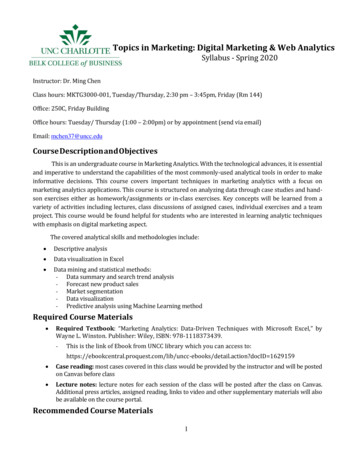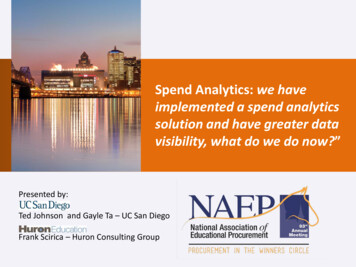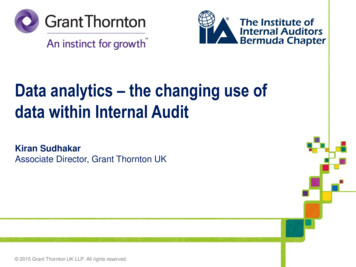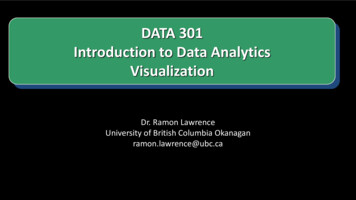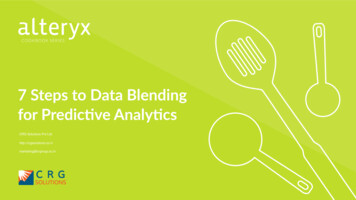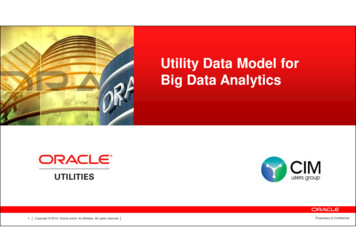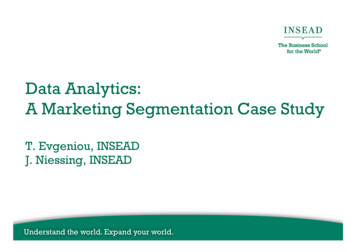
Transcription
Data Analytics:A Marketing Segmentation Case StudyT. Evgeniou, INSEADJ. Niessing, INSEAD
The Iterative Process CycleDataPreparation &ExplorationAnalysisGoal ofAnalysisPerformanceAssessment
Segmentation Methodology –A(nother) Process123456IdentifyBusinessIssuesClarifyScope andDimensionsGenerateand RefineHypothesesDecide onData touse /CollectNeededDataBuild theSegmentationFrameworkLink toMarketing &BusinessStrategy
A Segmentation (micro-)Process Segmentation solution is created through a rigorous and iterativeprocessData Processing/Factor AnalysisCluster analysesReview and refine
Why Segmentation? SEGMENTATION is a critical enabler to achieve business objectivesand realize benefits SEGMENTATION is critical to identify white spaces for newproducts/offerings SEGMENTATION helps organizations to optimize their retention andacquisition strategy SEGMENTATION is often used to optimize pricing across differentproducts SEGMENTATION enables organizations to become more customercentric MARKET DYNAMICS make segmentation critical to businesssuccess.
Questions You Might Hear These are only some of the issues that clients may raise thatclue you in to appropriateness of segmentationGrowth & NewOpportunitiesMarketStructureProduct DevelopmentChannel DeploymentResource AllocationRetention &AcquisitionMarketing ActivitiesPricing
Different Types of Data UsedtacticstrategicThere are different ways you can segment amarket, which result in different ways inwhich the segmentation can be used
Often different data sources willbe combined in one segmentationPrimary Data(Qual and Quant)Customer Data3rd Party DataSample variables:Sample variables:Sample variables: Behavioral Product/ServiceUsage Lifestyle Subscription Demographics Satisfaction Preferredcommunicationchannels Preferredengagement level Attitudes about theindustry Features usage Social Networkintegration Demographics Acquisition channel Behavioral
Overview of segment attitudes1Novices% Total Population: 17%% US Population: 18%% Brazil Population: 6%% Canada Population: 18%Who they are Rely more on expert opinion than their own Boating helps them escape from everyday lifeand relax Boating gives me a feeling of adventureWho they are not Not considered knowledgeable about boating Boating is not their true life passion Boating is not the #1 activity they do in theirspare time3Status Seekers% Total Population: 20%% US Population: 19%% Brazil Population: 29%% Canada Population: 18%Who they are Willing to pay a premium for a brand with areputation for high quality Buy the latest and greatest boats View their boat as a status symbolWho they are not Do not choose functionality over style Do not prefer a basic boat with little to nothrills Do not perform repairs and maintenance ontheir boats4Active FamilyBoaters2% Total Population: 23%% US Population: 29%% Brazil Population: 5%% Canada Population: 19%No Frills% Population: 15%Who they are Functionality is more important than style Perform repairs and maintenance on theirboats Tend to prefer a boat with little to no frillsWho they are not Do not go for the latest and greatest boat Having a powerful boat is not as importantto them Do not see the boat brand as saying a lotabout who they are% Total Population: 9%% US Population: 10%% Brazil Population: 7%% Canada Population: 10%Who they are Boating helps them stay active Boating allows them to excel in sportsthey’re passionate about Boating gives me an outlet to socialize withfamily and/or friendsWho they are not The lowest price is not more important thanboat brand Do not prefer a basic boat with little to nofrills Do not rely on expert opinion other thantheir own5Price drivenLifestylers% Total Population: 31%% US Population: 25%% Brazil Population: 53%% Canada Population: 33%Who they are Boating is their true passion in life Consider themselves more knowledgeablethan their boating peers Boating is the #1 activity they do in theirspare timeWho they are not Boating is not a means to escape fromeveryday life and relax Boating does not provide them with a senseof adventure9 They do not consider owning a boat as away of rewarding themselves for hard work
Overview of segments
Overview of segments
Motivated by imagePerceptual MapsRationale:Image ConsciousActive Social BoatersMotivated by functionalityLifestyle Boaters?Casual Boaters brand portfolio wasassessed within eachsegment to determinebrand strength, currentpenetration/share,perception on keysegment drivers vs. keycompetitors Strategic intent andcurrent positioning of thebrand was also consideredin the recommendationFunction-First BoatersBoating as an activityBoating as lifestyleNote: segment size based onrevenue contribution
Overview of segments
Link to Business Strategy6 Developing the appropriate strategy to go after identified targetsegments is key for every business1. BRAND PORTFOLIO & ARCHITECTURE STRATEGYHelps map out brands in the portfolio relative to meaningful/profitablyattractive customer segments Provides customer view of the business and brands and clarifies brand’sperceptual license to extendCUSTOMERSEGMENTATION 2. BRAND IDENTITY & POSITIONING STRATEGY Makes the link between brand associations and customer activity/behaviorCritical input to developing positioning platforms3. MARKETING EFFECTIVENESS Input to assessing customer purchase funnel in order to optimizeinvestments relative to priority segmentsHelps target profitable customer segments4. CUSTOMER EXPERIENCE Ensures that the experience is tailored to relevant customer segmentneeds
Link to Business Strategy6 Just building the segmentation is only half the battle1 Product/Offer2Pricing/ASS3 Marketing/Brand4 ding
Use of purchase funnels and regression modelingallows us to derive key drivers based on brandattributesFull list of brand attributeswill be grouped to factorsPriceClaim &CustomerserviceCoverageetce.g. Claim & Customer service Gives me personalized coverageGives me personalized serviceInteracts with me using a personal touchOffers fair claims settlementsEnsures that claims will be resolved tomy satisfaction Offers individual consultation Etc.Awareness?NonownersFamiliarityQuoteEver ownedCurrently ownedMultiple ryBottleneck1From the funnel section we are able to learn which are the critical bottlenecks across thepurchase process by country2Therefore, to determine what the key attributes are, we analyze which attributes drivecustomers through these specific bottlenecks by country
What Makes a “Good”Segmentation?Many different evaluation systems exist.Most deem a segmentation good if it meets these criteria
Key Tenants on Segmentation No one segmentation approach will work in all situations. The value in segmentation does not come from thesegmentation solution but from the programs leveragingthis solution. Segmentation should be “customer-in” versus business- orproduct-out. There is both a science and an “art” to designing andevaluating a successful segmentation. Segmentation is the foundation for distinctive andsustainable competitive advantage.
How a customer segmentation led to a newproduct category in the automotive sectorWith a tradition of producing small and mid-size general-purpose cars,Peugeot’s conservative European focus made it blind to the shift in globalcustomer demand.As a result, the Peugeot was one of the last of the big carmakers to enter themarket. With SUVs currently making 10% of European car sales and growing,this was a big mistake for Peugeot, who now only has 1% market share and hassuffered a double-digit global sales decline over the past five years.
How a customer segmentation led to newvalue propositionsCreated a segmentation to understand thenuanced needs, attitudes and behaviouralUsed the different customer segments to developtailored value propositions.Identified HelpPoints that could createsustainable differentiation that would bedifficult to compete away.LifeEDeValuate
Data Analytics: A Marketing Segmentation Case Study T. Evgeniou, INSEAD J. Niessing, INSEAD . The Iterative Process Cycle Goal of Analysis Data Preparation & Exploration Analysis Performance Assessment . Segmentation Methodology – A(nother) Process Identify Business Issues Clarify Scope and Dimensions Generate and Refine Hypotheses Decide on Data to use / Collect Needed Data Build

